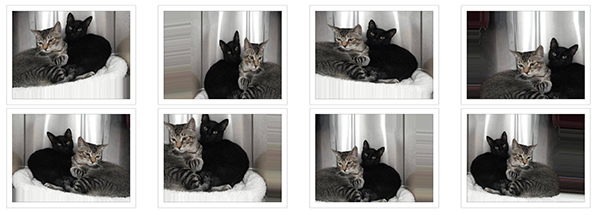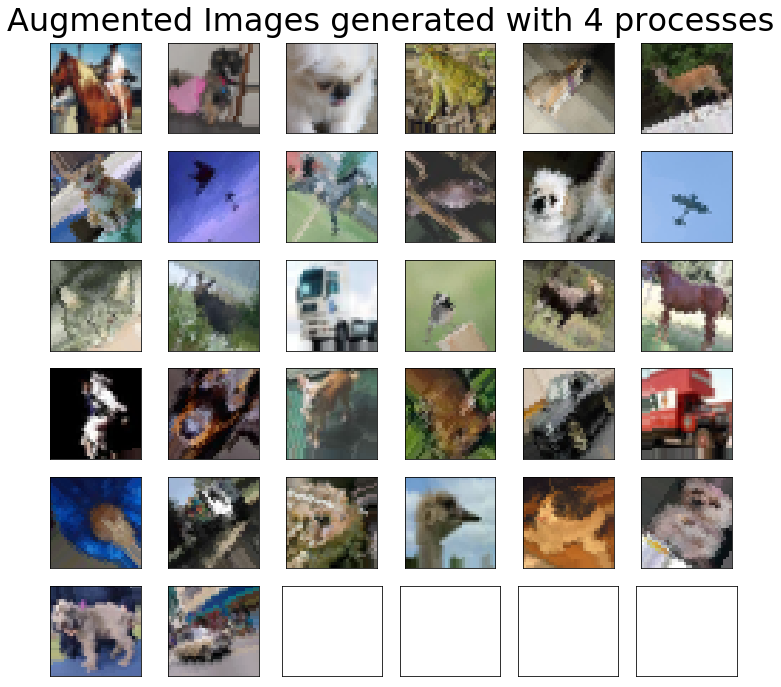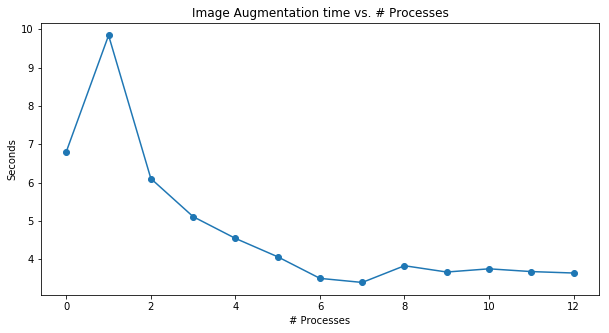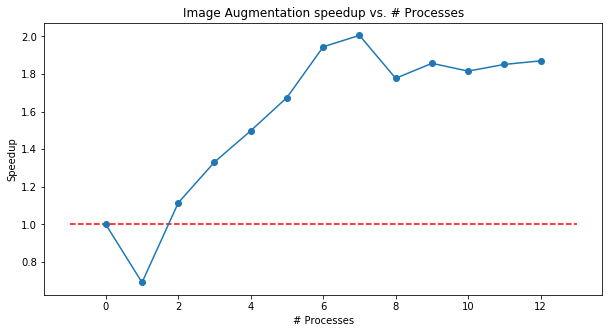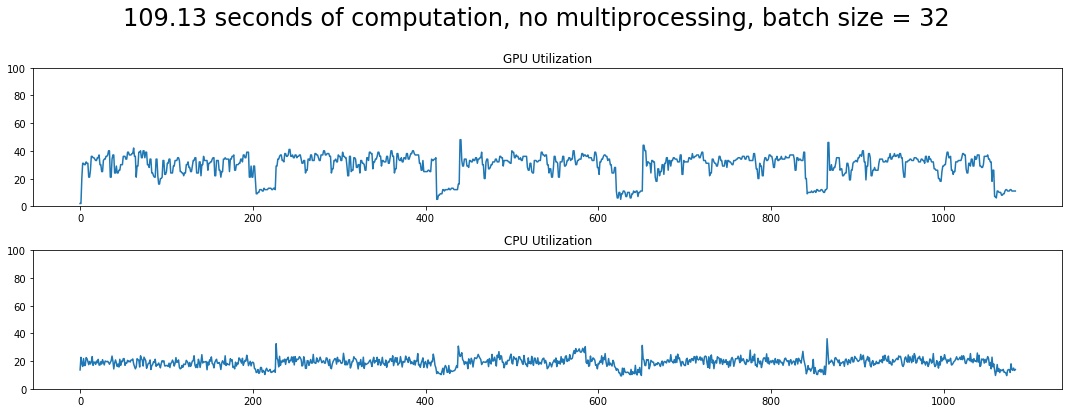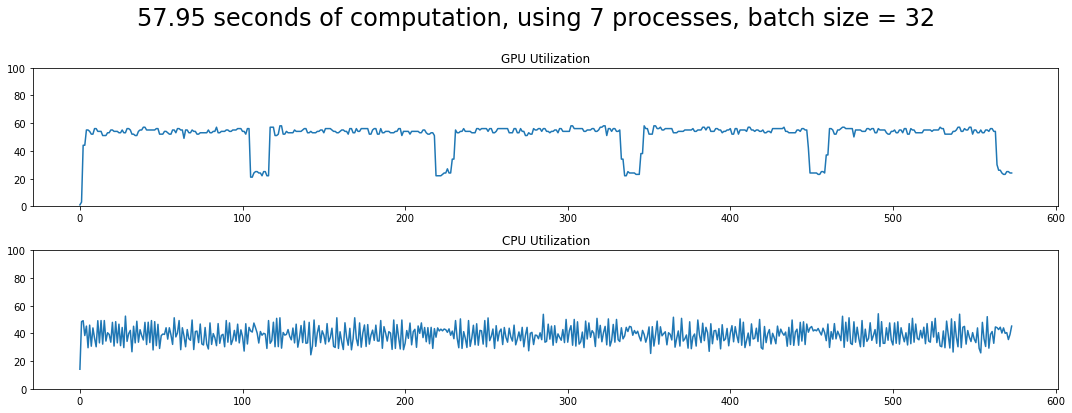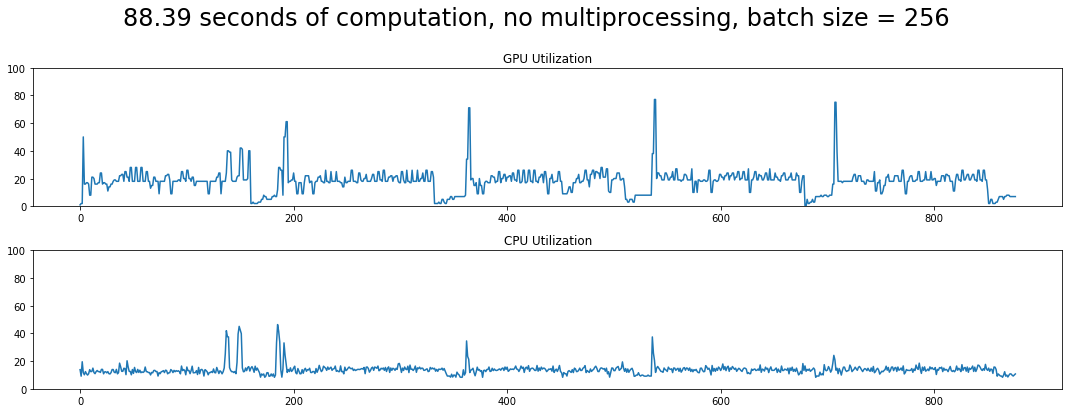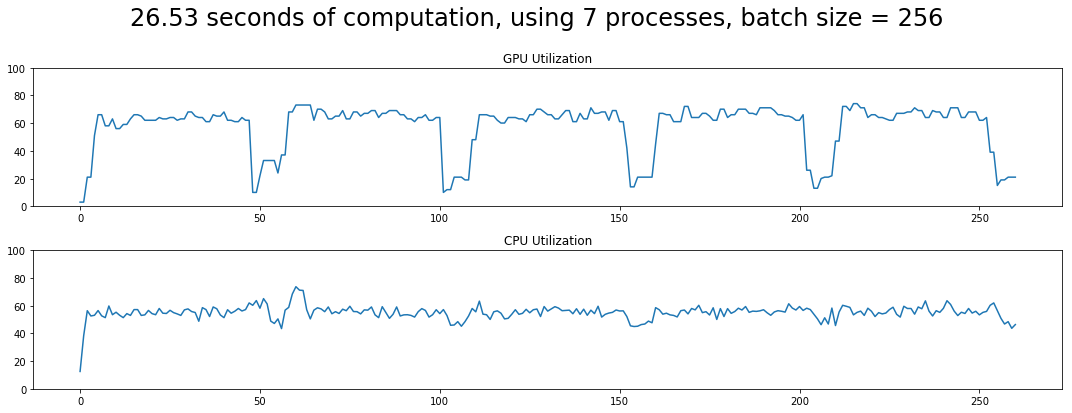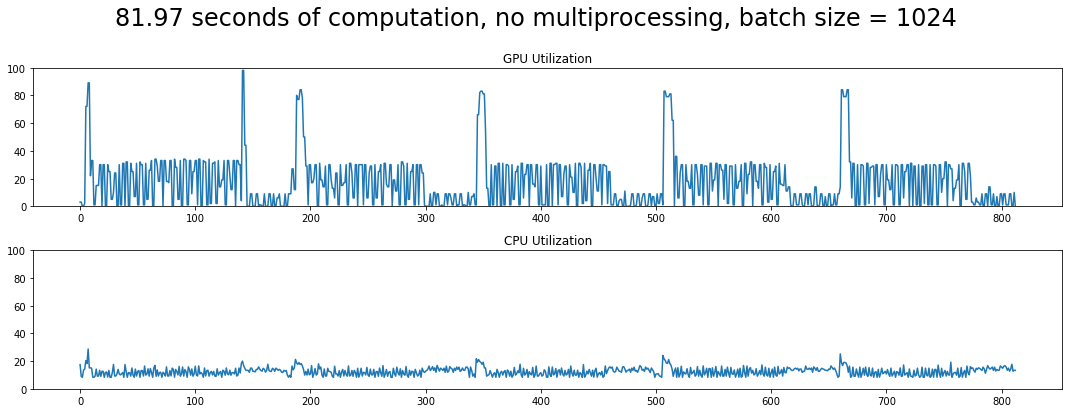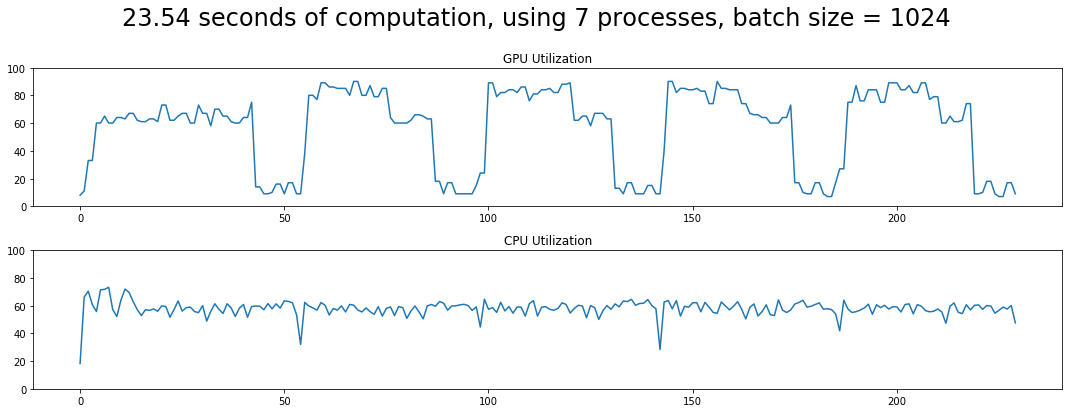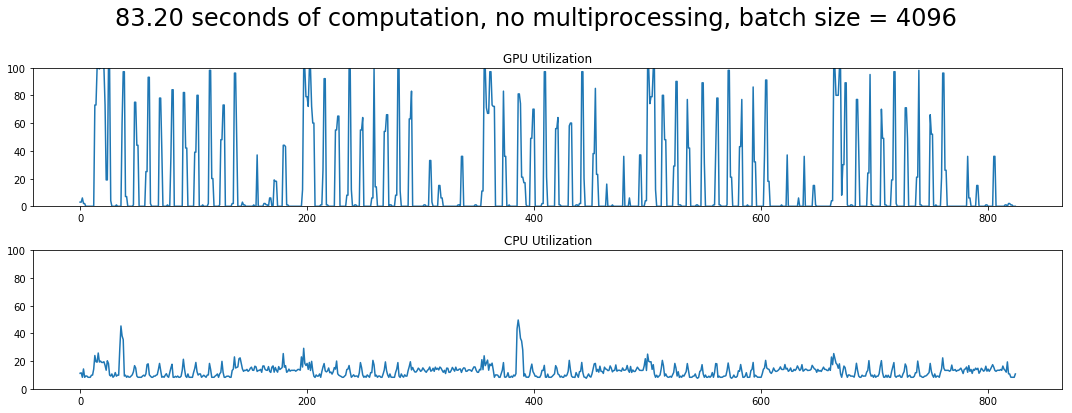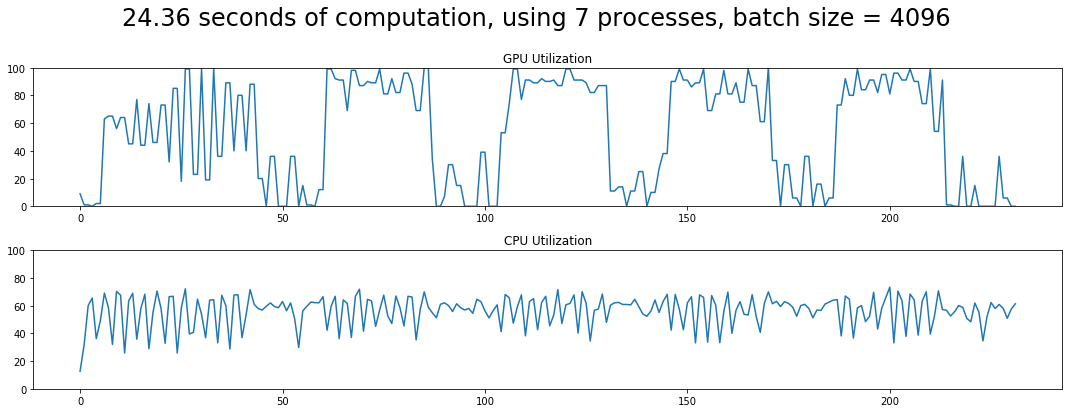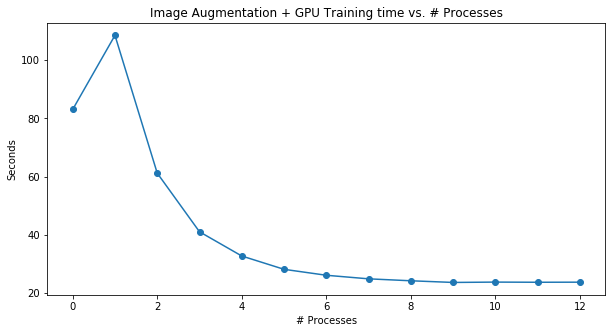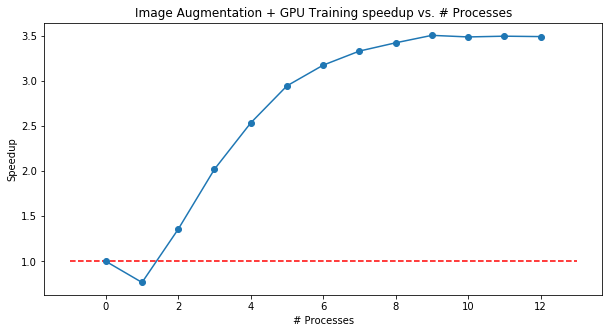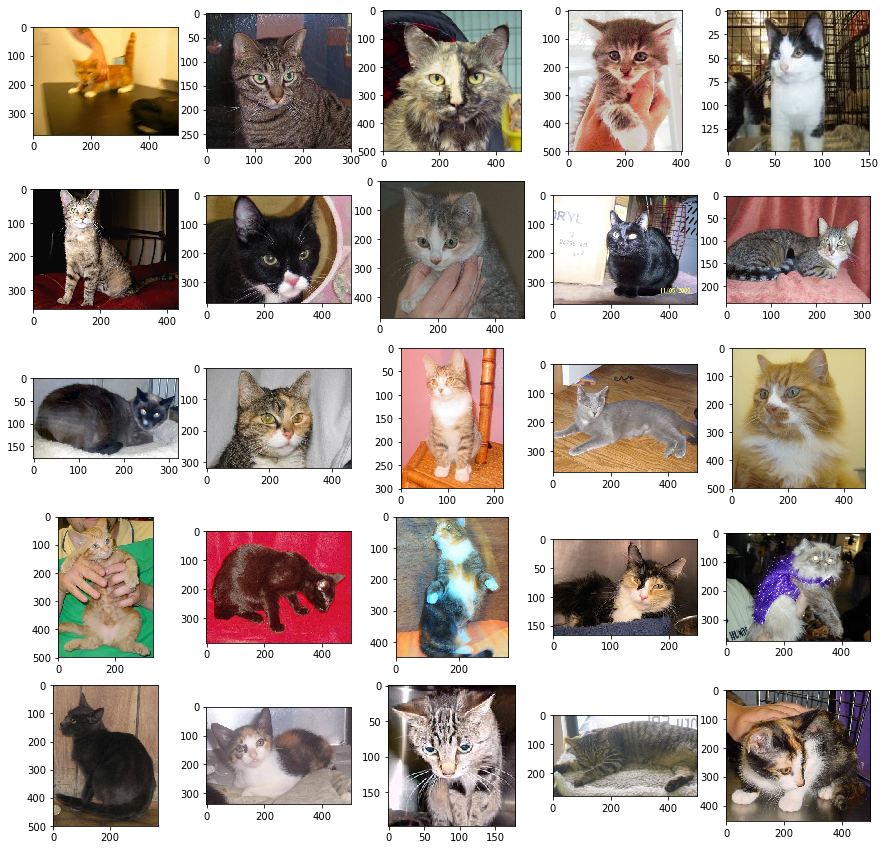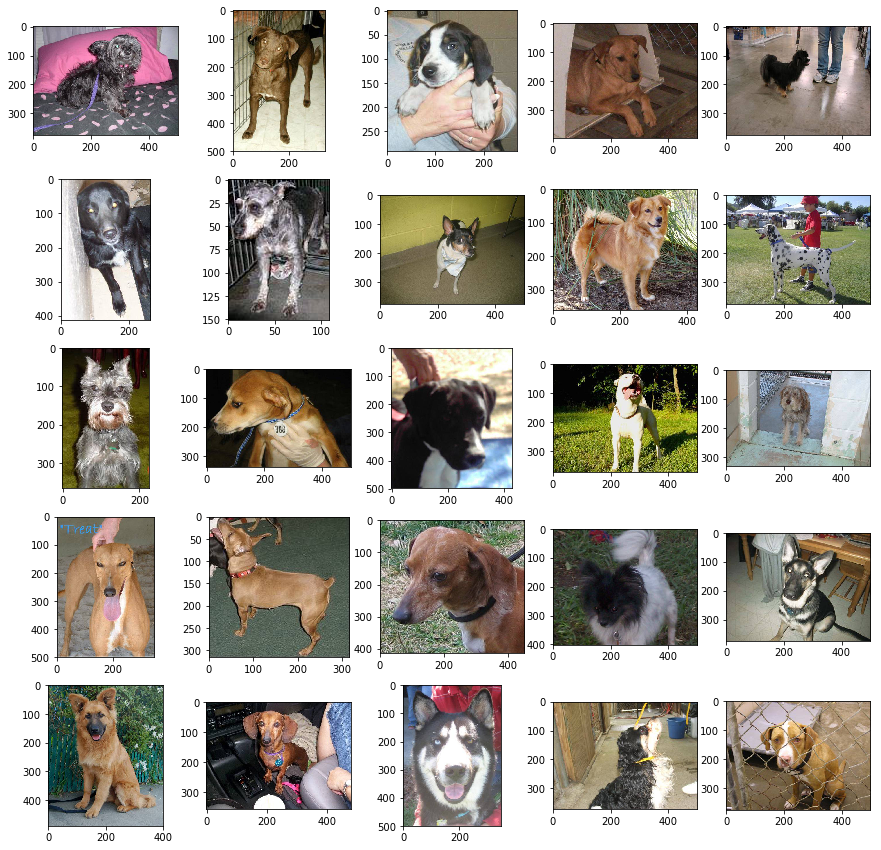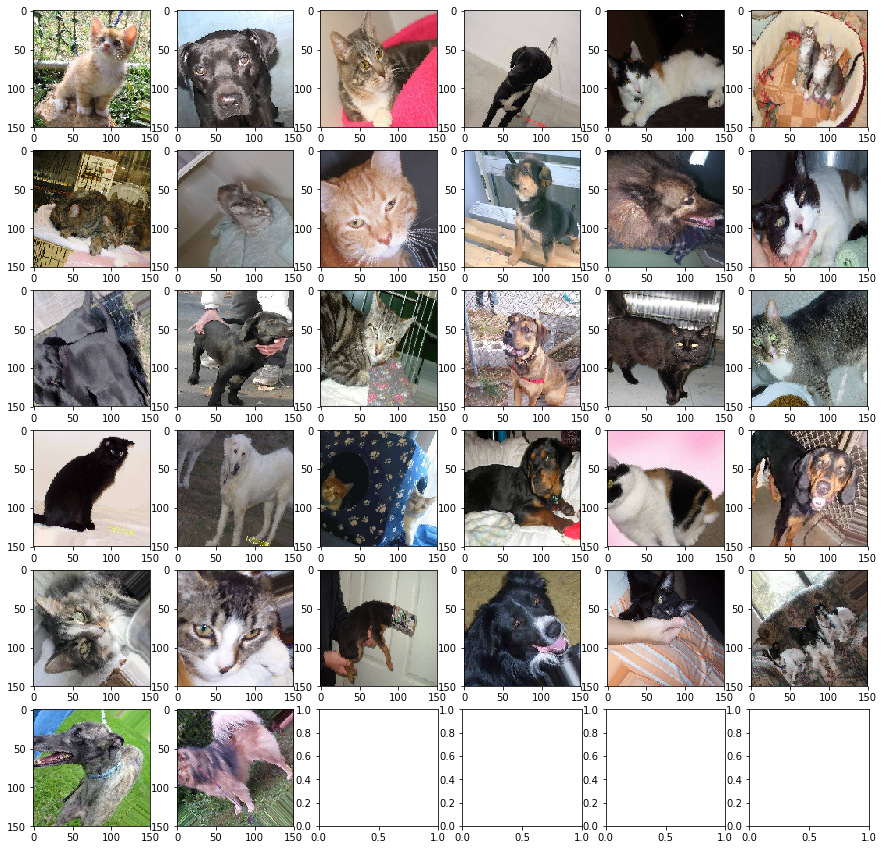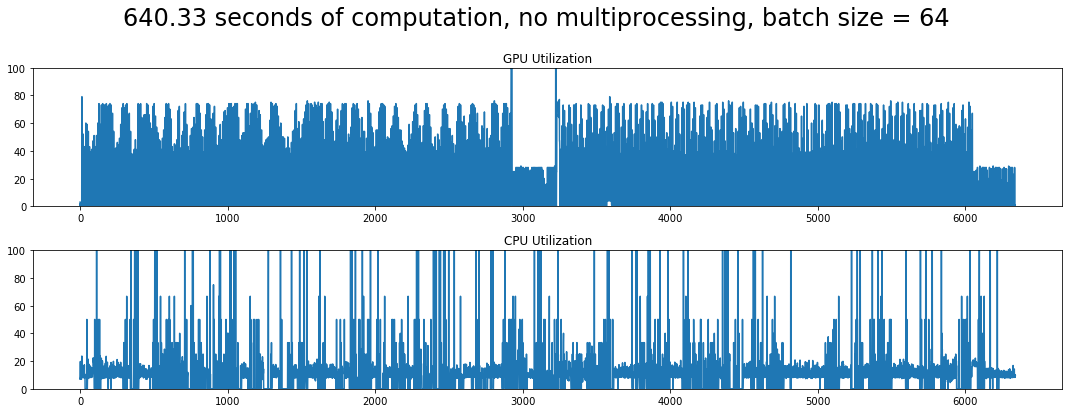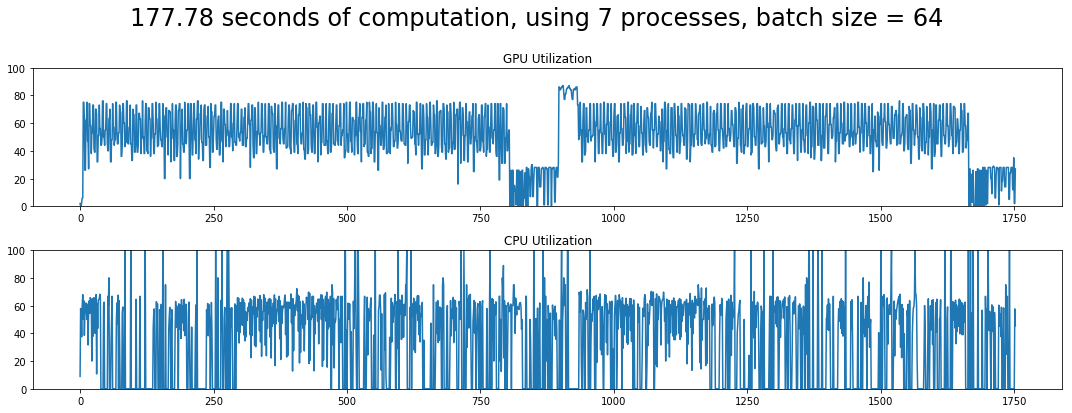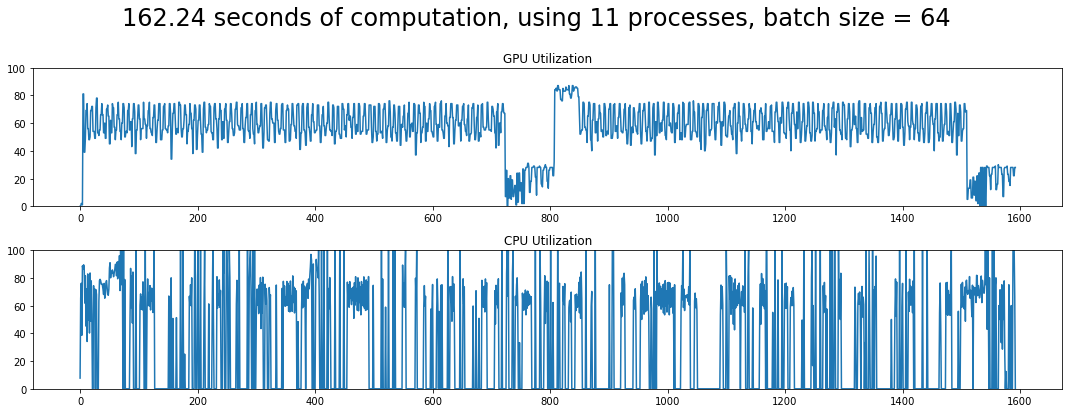Code available @ https://github.com/stratospark/keras-multiprocess-image-data-generator
- Introduction
- Benchmark: CIFAR10 - In Memory Performance, Image Generation Only
- Benchmark: CIFAR10 - In Memory Performance, Image Generation with GPU Training
- Benchmark: Dogs vs. Cats - On Disk Performance, Image Generation witih GPU Training
TLDR: By adding multiprocessing support to Keras ImageDataGenerator, benchmarking on a 6-core i7-6850K and 12GB TITAN X Pascal: 3.5x speedup of training with image augmentation on in memory datasets, 3.9x speedup of training with image augmentation on datasets streamed from disk.
When exploring Deep Learning models, it isn't only beneficial to have good performance for the final training run. Accelerating training speed means more network models can be tried and more hyperparameter settings can be explored in the same amount of time. The more that we can experiment, the better our results can become.
In my experience with training a moderately sized network on my home desktop, I found one bottleneck to be creating additional images to augment my dataset. Keras provides an ImageDataGenerator class that can take images, in memory or on disk, and create many different variations based on a set of parameters: rotations, flips, zooms, altering colors, etc. For reference, here is a great tutorial on improving network accuracy with image augmentation.
While training my initial models, I was waiting upwards of an entire day to see enough results to decide what to change. I saw that I was taking nowhere near full advantage of my CPU or GPU. As a result, I decided to add some Python multiprocessing support to a fork of ImageDataGenerator. I was able to drastically cut my training time and was finally able to steer my experiments in the right direction!
For reference, I am using:
- Intel Core i7-6850K
- NVIDIA TITAN X Pascal 12GB
- 96GB RAM
- 64-bit Ubuntu 16.04
- Python 2.7.13 :: Continuum Analytics, Inc.
- Keras 1.2.1
- Tensorflow 0.12.1
You can use the multiprocessing-enabled ImageDataGenerator that is included with this repo as a drop-in replacement for the version that currently ships with Keras. If it makes sense, the code may get incorporated into the main branch at some point.
import numpy as np
import pandas as pd
import keras as K
import matplotlib.pyplot as plt
import multiprocessing
import time
import collections
import sys
import signal
%matplotlib inlineUsing TensorFlow backend.
# The original class can be imported like this:
# from keras.preprocessing.image import ImageDataGenerator
# We access the modified version through T.ImageDataGenerator
import tools.image as T
# Useful for checking the output of the generators after code change
try:
from importlib import reload
reload(T)
except:
reload(T)These are helper methods used throughout the notebook.
def preprocess_img(img):
img = img.astype(np.float32) / 255.0
img -= 0.5
return img * 2def plot_images(img_gen, title):
fig, ax = plt.subplots(6, 6, figsize=(10, 10))
plt.suptitle(title, size=32)
plt.setp(ax, xticks=[], yticks=[])
plt.tight_layout(rect=[0, 0.03, 1, 0.95])
for (imgs, labels) in img_gen:
for i in range(6):
for j in range(6):
if i*6 + j < 32:
ax[i][j].imshow(imgs[i*6 + j])
break CIFAR10 is a toy dataset that includes 50,000 training images and 10,000 test images of shape 32x32x3.
It includes the following 10 classes: airplane, automobile, bird, cat, deer, dog, frog, horse, ship, truck
from keras.datasets.cifar10 import load_data
from keras.utils.np_utils import to_categorical
(X_train, y_train), (X_test, y_test) = load_data()
y_train_cat = to_categorical(y_train)
y_test_cat = to_categorical(y_test)Here is an example of how to set up a multiprocessing.Pool and add it as an argument to the ImageDataGenerator constructor. This is the only change to the class' public interface. If you leave out the pool parameter or set it to None, the generator will operate in its original single process mode.
try:
pool.terminate()
except:
pass
n_process = 4
pool = multiprocessing.Pool(processes=n_process)
start = time.time()
gen = T.ImageDataGenerator(
featurewise_center=False,
samplewise_center=False,
featurewise_std_normalization=False,
samplewise_std_normalization=False,
zca_whitening=False,
rotation_range=45,
width_shift_range=.1,
height_shift_range=.1,
shear_range=0.,
zoom_range=0,
channel_shift_range=0,
fill_mode='nearest',
cval=0.,
horizontal_flip=True,
vertical_flip=False,
rescale=1/255.,
#preprocessing_function=preprocess_img, # disable for nicer visualization
dim_ordering='default',
pool=pool # <-------------- Only change needed!
)
gen.fit(X_train)
X_train_aug = gen.flow(X_train, y_train_cat, seed=0)
print('{} process, duration: {}'.format(4, time.time() - start))
plot_images(X_train_aug, 'Augmented Images generated with {} processes'.format(n_process))
pool.terminate()4 process, duration: 0.0404160022736
Now that we have verified that the images are being properly generated with multiple processes, we want to benchmark how the number of processes affects performance. Idealy, we would like to see speedups scale linearly with the number of processes added. However, as explained by Amdahl's Law, there are diminishing returns due to additional overhead.
The following benchmark will first test image augmentation without multiprocessing, then do a test for an increasing number of processes, up to a max of the number of logical CPUs your system has. It does multiple rounds of these tests so that we may average the results.
durs = collections.defaultdict(list)
num_cores = 2
try:
num_cores = multiprocessing.cpu_count()
except:
pass
for j in range(10):
print('Round', j)
for num_p in range(0, num_cores + 1):
pool = None
if num_p > 0:
pool = multiprocessing.Pool(processes=num_p)
start = time.time()
gen = T.ImageDataGenerator(
featurewise_center=False,
samplewise_center=False,
featurewise_std_normalization=False,
samplewise_std_normalization=False,
zca_whitening=False,
rotation_range=45,
width_shift_range=.1,
height_shift_range=.1,
shear_range=0.,
zoom_range=0,
channel_shift_range=0,
fill_mode='nearest',
cval=0.,
horizontal_flip=True,
vertical_flip=False,
rescale=None,
preprocessing_function=preprocess_img,
dim_ordering='default',
pool=pool
)
gen.fit(X_train)
X_train_aug = gen.flow(X_train, y_train_cat, seed=0)
for i, (imgs, labels) in enumerate(X_train_aug):
if i == 1000:
break
dur = time.time() - start
#print(num_p, dur)
sys.stdout.write('{}: {} ... '.format(num_p, dur))
sys.stdout.flush()
durs[num_p].append(dur)
if pool:
pool.terminate()('Round', 0)
0: 6.84576511383 ... 1: 9.6486890316 ... 2: 6.03799390793 ... 3: 4.88081693649 ... 4: 4.66870999336 ... 5: 3.70913481712 ... 6: 3.27630805969 ... 7: 3.48509907722 ... 8: 3.64657878876 ... 9: 3.74150896072 ... 10: 3.57441878319 ... 11: 3.60130214691 ... 12: 3.47499299049 ... ('Round', 1)
0: 6.75701498985 ... 1: 9.94960093498 ... 2: 5.64250087738 ... 3: 5.06900811195 ... 4: 4.61409282684 ... 5: 4.57506585121 ... 6: 3.48270392418 ... 7: 3.51494693756 ... 8: 3.88235402107 ... 9: 3.62926697731 ... 10: 3.91224503517 ... 11: 3.59025716782 ... 12: 3.5045068264 ... ('Round', 2)
0: 6.90472793579 ... 1: 9.55179905891 ... 2: 6.57418012619 ... 3: 5.2566280365 ... 4: 4.55560803413 ... 5: 4.45380306244 ... 6: 3.54513192177 ... 7: 3.21149206161 ... 8: 3.78789710999 ... 9: 3.67751908302 ... 10: 3.74882698059 ... 11: 3.98700881004 ... 12: 3.64187002182 ... ('Round', 3)
0: 6.82807612419 ... 1: 9.48674917221 ... 2: 5.57596802711 ... 3: 4.74470591545 ... 4: 4.18711090088 ... 5: 3.89195489883 ... 6: 3.22924613953 ... 7: 3.17622900009 ... 8: 4.07523298264 ... 9: 3.59954690933 ... 10: 3.7366130352 ... 11: 3.52489495277 ... 12: 3.82451415062 ... ('Round', 4)
0: 6.73704409599 ... 1: 9.2156291008 ... 2: 6.23566198349 ... 3: 5.13580393791 ... 4: 4.71229195595 ... 5: 3.35283398628 ... 6: 3.24846291542 ... 7: 3.79010605812 ... 8: 3.74294400215 ... 9: 3.76095604897 ... 10: 3.7142059803 ... 11: 3.54178500175 ... 12: 3.72024703026 ... ('Round', 5)
0: 6.75245904922 ... 1: 10.7912859917 ... 2: 6.79878306389 ... 3: 4.67795395851 ... 4: 4.7692129612 ... 5: 3.99766302109 ... 6: 3.45177388191 ... 7: 3.30268979073 ... 8: 3.92767882347 ... 9: 3.69342398643 ... 10: 3.52480602264 ... 11: 3.46998000145 ... 12: 3.60531187057 ... ('Round', 6)
0: 6.94973492622 ... 1: 9.72229290009 ... 2: 6.76698184013 ... 3: 5.28792905807 ... 4: 4.44634389877 ... 5: 4.34274101257 ... 6: 3.94904899597 ... 7: 3.34885692596 ... 8: 3.69488501549 ... 9: 3.87995219231 ... 10: 3.78279495239 ... 11: 3.49752092361 ... 12: 3.56351184845 ... ('Round', 7)
0: 6.71522402763 ... 1: 10.2026801109 ... 2: 6.04175400734 ... 3: 5.20836210251 ... 4: 4.35653805733 ... 5: 4.39560294151 ... 6: 3.74392104149 ... 7: 3.19262504578 ... 8: 3.89874505997 ... 9: 3.41301083565 ... 10: 3.79124188423 ... 11: 3.90449810028 ... 12: 3.74271798134 ... ('Round', 8)
0: 6.8355588913 ... 1: 9.49789810181 ... 2: 5.33640003204 ... 3: 5.41973185539 ... 4: 4.42942810059 ... 5: 4.30604100227 ... 6: 3.22810721397 ... 7: 3.24005103111 ... 8: 3.61394405365 ... 9: 3.50949716568 ... 10: 3.62207698822 ... 11: 3.84033894539 ... 12: 3.85311603546 ... ('Round', 9)
0: 6.74057507515 ... 1: 10.3358399868 ... 2: 6.02810311317 ... 3: 5.41968894005 ... 4: 4.69001197815 ... 5: 3.6060628891 ... 6: 3.84348988533 ... 7: 3.67217493057 ... 8: 4.02522802353 ... 9: 3.74887800217 ... 10: 4.08099198341 ... 11: 3.81078886986 ... 12: 3.46359109879 ...
df = pd.DataFrame(durs)
df| 0 | 1 | 2 | 3 | 4 | 5 | 6 | 7 | 8 | 9 | 10 | 11 | 12 | |
|---|---|---|---|---|---|---|---|---|---|---|---|---|---|
| 0 | 6.845765 | 9.648689 | 6.037994 | 4.880817 | 4.668710 | 3.709135 | 3.276308 | 3.485099 | 3.646579 | 3.741509 | 3.574419 | 3.601302 | 3.474993 |
| 1 | 6.757015 | 9.949601 | 5.642501 | 5.069008 | 4.614093 | 4.575066 | 3.482704 | 3.514947 | 3.882354 | 3.629267 | 3.912245 | 3.590257 | 3.504507 |
| 2 | 6.904728 | 9.551799 | 6.574180 | 5.256628 | 4.555608 | 4.453803 | 3.545132 | 3.211492 | 3.787897 | 3.677519 | 3.748827 | 3.987009 | 3.641870 |
| 3 | 6.828076 | 9.486749 | 5.575968 | 4.744706 | 4.187111 | 3.891955 | 3.229246 | 3.176229 | 4.075233 | 3.599547 | 3.736613 | 3.524895 | 3.824514 |
| 4 | 6.737044 | 9.215629 | 6.235662 | 5.135804 | 4.712292 | 3.352834 | 3.248463 | 3.790106 | 3.742944 | 3.760956 | 3.714206 | 3.541785 | 3.720247 |
| 5 | 6.752459 | 10.791286 | 6.798783 | 4.677954 | 4.769213 | 3.997663 | 3.451774 | 3.302690 | 3.927679 | 3.693424 | 3.524806 | 3.469980 | 3.605312 |
| 6 | 6.949735 | 9.722293 | 6.766982 | 5.287929 | 4.446344 | 4.342741 | 3.949049 | 3.348857 | 3.694885 | 3.879952 | 3.782795 | 3.497521 | 3.563512 |
| 7 | 6.715224 | 10.202680 | 6.041754 | 5.208362 | 4.356538 | 4.395603 | 3.743921 | 3.192625 | 3.898745 | 3.413011 | 3.791242 | 3.904498 | 3.742718 |
| 8 | 6.835559 | 9.497898 | 5.336400 | 5.419732 | 4.429428 | 4.306041 | 3.228107 | 3.240051 | 3.613944 | 3.509497 | 3.622077 | 3.840339 | 3.853116 |
| 9 | 6.740575 | 10.335840 | 6.028103 | 5.419689 | 4.690012 | 3.606063 | 3.843490 | 3.672175 | 4.025228 | 3.748878 | 4.080992 | 3.810789 | 3.463591 |
df_mean = pd.DataFrame(df.mean(axis=0))
plt.figure(figsize=(10,5))
plt.plot(df_mean, marker='o')
plt.xlabel('# Processes')
plt.ylabel('Seconds')
plt.title('Image Augmentation time vs. # Processes')<matplotlib.text.Text at 0x7fcd54312a10>
speedups = 1 / (df_mean / df_mean[0][0])
plt.figure(figsize=(10,5))
plt.plot(speedups, marker='o')
plt.xlabel('# Processes')
plt.ylabel('Speedup')
plt.hlines(1, -1, df_mean.shape[0], colors='red', linestyles='dashed')
plt.title('Image Augmentation speedup vs. # Processes')<matplotlib.text.Text at 0x7fcd543f6950>
best_ix = np.argmax(speedups.values)
print('Best speedup: {0:.2f}x with {1} processes.'.format(speedups.values[best_ix][0], best_ix))Best speedup: 2.01x with 7 processes.
As we can see, we are able to cut image generation time in half. However, does the speedup remain when we are also sending the images to the GPU for network trianing?
import tools.sysmonitor as SM
reload(SM)<module 'tools.sysmonitor' from 'tools/sysmonitor.pyc'>
Let us take a model from one of the Keras examples:
from keras.models import Sequential
from keras.layers import Conv2D, Activation, MaxPooling2D, Dropout, Flatten, Dense
model = Sequential()
model.add(Conv2D(32, 3, 3, border_mode='same',
input_shape=(32, 32, 3)))
model.add(Activation('relu'))
model.add(Conv2D(32, 3, 3))
model.add(Activation('relu'))
model.add(MaxPooling2D(pool_size=(2, 2)))
model.add(Dropout(0.25))
model.add(Conv2D(64, 3, 3, border_mode='same'))
model.add(Activation('relu'))
model.add(Conv2D(64, 3, 3))
model.add(Activation('relu'))
model.add(MaxPooling2D(pool_size=(2, 2)))
model.add(Dropout(0.25))
model.add(Flatten())
model.add(Dense(512))
model.add(Activation('relu'))
model.add(Dropout(0.5))
model.add(Dense(10))
model.add(Activation('softmax'))
model.summary()
model.compile(optimizer='adam', loss='categorical_crossentropy', metrics=['accuracy'])____________________________________________________________________________________________________
Layer (type) Output Shape Param # Connected to
====================================================================================================
convolution2d_8 (Convolution2D) (None, 32, 32, 32) 896 convolution2d_input_3[0][0]
____________________________________________________________________________________________________
activation_12 (Activation) (None, 32, 32, 32) 0 convolution2d_8[0][0]
____________________________________________________________________________________________________
convolution2d_9 (Convolution2D) (None, 30, 30, 32) 9248 activation_12[0][0]
____________________________________________________________________________________________________
activation_13 (Activation) (None, 30, 30, 32) 0 convolution2d_9[0][0]
____________________________________________________________________________________________________
maxpooling2d_6 (MaxPooling2D) (None, 15, 15, 32) 0 activation_13[0][0]
____________________________________________________________________________________________________
dropout_5 (Dropout) (None, 15, 15, 32) 0 maxpooling2d_6[0][0]
____________________________________________________________________________________________________
convolution2d_10 (Convolution2D) (None, 15, 15, 64) 18496 dropout_5[0][0]
____________________________________________________________________________________________________
activation_14 (Activation) (None, 15, 15, 64) 0 convolution2d_10[0][0]
____________________________________________________________________________________________________
convolution2d_11 (Convolution2D) (None, 13, 13, 64) 36928 activation_14[0][0]
____________________________________________________________________________________________________
activation_15 (Activation) (None, 13, 13, 64) 0 convolution2d_11[0][0]
____________________________________________________________________________________________________
maxpooling2d_7 (MaxPooling2D) (None, 6, 6, 64) 0 activation_15[0][0]
____________________________________________________________________________________________________
dropout_6 (Dropout) (None, 6, 6, 64) 0 maxpooling2d_7[0][0]
____________________________________________________________________________________________________
flatten_3 (Flatten) (None, 2304) 0 dropout_6[0][0]
____________________________________________________________________________________________________
dense_5 (Dense) (None, 512) 1180160 flatten_3[0][0]
____________________________________________________________________________________________________
activation_16 (Activation) (None, 512) 0 dense_5[0][0]
____________________________________________________________________________________________________
dropout_7 (Dropout) (None, 512) 0 activation_16[0][0]
____________________________________________________________________________________________________
dense_6 (Dense) (None, 10) 5130 dropout_7[0][0]
____________________________________________________________________________________________________
activation_17 (Activation) (None, 10) 0 dense_6[0][0]
====================================================================================================
Total params: 1,250,858
Trainable params: 1,250,858
Non-trainable params: 0
____________________________________________________________________________________________________
When we are running lengthier training sessions, we may want to interrupt training to try a different approach: tweak hyperparameters, choose a different optimizer, adjust the network architecture, etc. In order to handle this gracefully with multiprocessing, we need to tell the child processes to ignore the interrupt signals. The parent process will catch the KeyboardInterrupt exception allow us to continue working interactively in the Notebook. Without this infrastructure, the processes will remain in limbo as detailed here.
pool = None
def init_worker():
signal.signal(signal.SIGINT, signal.SIG_IGN)def setup_generator(processes=None, batch_size=32):
global pool
try:
pool.terminate()
except:
pass
if processes:
pool = multiprocessing.Pool(processes=processes, initializer=init_worker)
else:
pool = None
gen = T.ImageDataGenerator(
featurewise_center=False,
samplewise_center=False,
featurewise_std_normalization=False,
samplewise_std_normalization=False,
zca_whitening=False,
rotation_range=45,
width_shift_range=.1,
height_shift_range=.1,
shear_range=0.,
zoom_range=[.8, 1],
channel_shift_range=20,
fill_mode='nearest',
cval=0.,
horizontal_flip=True,
vertical_flip=False,
rescale=None,
preprocessing_function=preprocess_img,
dim_ordering='default',
pool=pool
)
test_gen = T.ImageDataGenerator(
preprocessing_function=preprocess_img,
pool=pool
)
gen.fit(X_train)
test_gen.fit(X_train)
X_train_aug = gen.flow(X_train, y_train_cat, seed=0, batch_size=batch_size)
X_test_aug = test_gen.flow(X_test, y_test_cat, seed=0, batch_size=batch_size)
return X_train_aug, X_test_augdef run_benchmark(processes=None, batch_size=32, vert=True, plot=True):
X_train_aug, X_test_aug = setup_generator(processes=processes, batch_size=batch_size)
sys_mon = SM.SysMonitor()
sys_mon.start()
try:
model.fit_generator(X_train_aug, samples_per_epoch=50000, nb_epoch=5,
validation_data=X_test_aug, nb_val_samples=10000)
except KeyboardInterrupt:
print '\n\nTraining Interrupted\n'
return None
sys_mon.stop()
title = None
if not processes:
title = '{0:.2f} seconds of computation, no multiprocessing, batch size = {1}'.format(sys_mon.duration, batch_size)
else:
title = '{0:.2f} seconds of computation, using {1} processes, batch size = {2}'.format(sys_mon.duration, processes, batch_size)
if plot:
sys_mon.plot(title, vert)
if not processes:
processes = 0
return {
'processes': processes,
'batch_size': batch_size,
'duration': sys_mon.duration,
'title': title
}run_benchmark(processes=None, batch_size=32)Epoch 1/5
3552/50000 [=>............................] - ETA: 29s - loss: 2.1171 - acc: 0.2030
Training Interrupted
run_benchmark(processes=7, batch_size=32)Epoch 1/5
11136/50000 [=====>........................] - ETA: 8s - loss: 1.8752 - acc: 0.3081
Training Interrupted
Now let's try a variety of different test scenarios:
runs = []runs.append(run_benchmark(processes=None, batch_size=32))Epoch 1/5
50000/50000 [==============================] - 22s - loss: 1.1598 - acc: 0.5941 - val_loss: 0.8368 - val_acc: 0.7077
Epoch 2/5
50000/50000 [==============================] - 21s - loss: 1.1457 - acc: 0.6003 - val_loss: 0.8865 - val_acc: 0.6907
Epoch 3/5
50000/50000 [==============================] - 21s - loss: 1.1311 - acc: 0.6031 - val_loss: 0.8255 - val_acc: 0.7190
Epoch 4/5
50000/50000 [==============================] - 21s - loss: 1.1232 - acc: 0.6060 - val_loss: 0.8367 - val_acc: 0.7142
Epoch 5/5
50000/50000 [==============================] - 22s - loss: 1.1075 - acc: 0.6116 - val_loss: 0.8358 - val_acc: 0.7054
runs.append(run_benchmark(processes=7, batch_size=32))Epoch 1/5
50000/50000 [==============================] - 11s - loss: 1.0912 - acc: 0.6165 - val_loss: 0.8329 - val_acc: 0.7103
Epoch 2/5
50000/50000 [==============================] - 11s - loss: 1.0838 - acc: 0.6232 - val_loss: 0.8299 - val_acc: 0.7053
Epoch 3/5
50000/50000 [==============================] - 11s - loss: 1.0736 - acc: 0.6245 - val_loss: 0.8385 - val_acc: 0.7092
Epoch 4/5
50000/50000 [==============================] - 11s - loss: 1.0671 - acc: 0.6258 - val_loss: 0.7994 - val_acc: 0.7238
Epoch 5/5
50000/50000 [==============================] - 11s - loss: 1.0670 - acc: 0.6283 - val_loss: 0.8347 - val_acc: 0.7133
runs[0]['duration'] / runs[1]['duration']1.8832975152491378
As we can see, we can get a 1.8x speedup by using 7 processes. The GPU and CPU utilization is markedly higher and more consistent.
Let's see if batch size affects the outcome:
runs.append(run_benchmark(processes=None, batch_size=256))Epoch 1/5
50000/50000 [==============================] - 19s - loss: 1.0319 - acc: 0.6400 - val_loss: 0.7463 - val_acc: 0.7389
Epoch 2/5
50000/50000 [==============================] - 17s - loss: 1.0013 - acc: 0.6495 - val_loss: 0.7436 - val_acc: 0.7416
Epoch 3/5
50000/50000 [==============================] - 17s - loss: 0.9910 - acc: 0.6537 - val_loss: 0.7253 - val_acc: 0.7484
Epoch 4/5
50000/50000 [==============================] - 17s - loss: 0.9824 - acc: 0.6582 - val_loss: 0.7271 - val_acc: 0.7499
Epoch 5/5
50000/50000 [==============================] - 17s - loss: 0.9752 - acc: 0.6600 - val_loss: 0.6967 - val_acc: 0.7607
runs.append(run_benchmark(processes=7, batch_size=256))Epoch 1/5
50000/50000 [==============================] - 5s - loss: 0.9585 - acc: 0.6660 - val_loss: 0.7220 - val_acc: 0.7495
Epoch 2/5
50000/50000 [==============================] - 5s - loss: 0.9553 - acc: 0.6671 - val_loss: 0.7071 - val_acc: 0.7546
Epoch 3/5
50000/50000 [==============================] - 5s - loss: 0.9502 - acc: 0.6690 - val_loss: 0.6920 - val_acc: 0.7640
Epoch 4/5
50000/50000 [==============================] - 5s - loss: 0.9525 - acc: 0.6687 - val_loss: 0.7103 - val_acc: 0.7558
Epoch 5/5
50000/50000 [==============================] - 5s - loss: 0.9452 - acc: 0.6713 - val_loss: 0.6999 - val_acc: 0.7565
runs[2]['duration'] / runs[3]['duration']3.3318531284663795
With a batch size of 256, we get an even larger speedup of 3.3x
runs.append(run_benchmark(processes=None, batch_size=1024))Epoch 1/5
50000/50000 [==============================] - 18s - loss: 0.9383 - acc: 0.6709 - val_loss: 0.6876 - val_acc: 0.7634
Epoch 2/5
50000/50000 [==============================] - 15s - loss: 0.9310 - acc: 0.6733 - val_loss: 0.6851 - val_acc: 0.7626
Epoch 3/5
50000/50000 [==============================] - 16s - loss: 0.9226 - acc: 0.6794 - val_loss: 0.6783 - val_acc: 0.7701
Epoch 4/5
50000/50000 [==============================] - 15s - loss: 0.9230 - acc: 0.6785 - val_loss: 0.6884 - val_acc: 0.7651
Epoch 5/5
50000/50000 [==============================] - 15s - loss: 0.9152 - acc: 0.6809 - val_loss: 0.6682 - val_acc: 0.7695
runs.append(run_benchmark(processes=7, batch_size=1024))Epoch 1/5
50000/50000 [==============================] - 5s - loss: 0.9137 - acc: 0.6815 - val_loss: 0.6798 - val_acc: 0.7661
Epoch 2/5
50000/50000 [==============================] - 4s - loss: 0.9161 - acc: 0.6814 - val_loss: 0.6771 - val_acc: 0.7649
Epoch 3/5
50000/50000 [==============================] - 4s - loss: 0.9125 - acc: 0.6812 - val_loss: 0.6759 - val_acc: 0.7691
Epoch 4/5
50000/50000 [==============================] - 4s - loss: 0.9133 - acc: 0.6814 - val_loss: 0.6786 - val_acc: 0.7673
Epoch 5/5
50000/50000 [==============================] - 4s - loss: 0.9139 - acc: 0.6812 - val_loss: 0.6574 - val_acc: 0.7707
runs[4]['duration'] / runs[5]['duration']3.4816410549495163
With a batch size of 1024, we get a speedup of 3.48%. We also notice an interesting phenomenon. Without multiprocessing, the GPU is interittently going to 0 utilization. However, with 7 processes, we can see consistent >60% GPU utilization with a long initial period of >80%. Notice that with this batch size, we are able to get to lower losses a lot quicker than with lower batch sizes. This pattern will not necessarily continue with additional epochs, but it may be promising in some cases.
runs.append(run_benchmark(processes=None, batch_size=4096))Epoch 1/5
50000/50000 [==============================] - 19s - loss: 0.9059 - acc: 0.6812 - val_loss: 0.6704 - val_acc: 0.7696
Epoch 2/5
50000/50000 [==============================] - 16s - loss: 0.9116 - acc: 0.6829 - val_loss: 0.6654 - val_acc: 0.7666
Epoch 3/5
50000/50000 [==============================] - 14s - loss: 0.9002 - acc: 0.6867 - val_loss: 0.6626 - val_acc: 0.7719
Epoch 4/5
50000/50000 [==============================] - 16s - loss: 0.8984 - acc: 0.6863 - val_loss: 0.6678 - val_acc: 0.7688
Epoch 5/5
50000/50000 [==============================] - 15s - loss: 0.9041 - acc: 0.6847 - val_loss: 0.6647 - val_acc: 0.7663
runs.append(run_benchmark(processes=7, batch_size=4096))Epoch 1/5
50000/50000 [==============================] - 6s - loss: 0.9057 - acc: 0.6823 - val_loss: 0.6678 - val_acc: 0.7680
Epoch 2/5
50000/50000 [==============================] - 4s - loss: 0.9003 - acc: 0.6881 - val_loss: 0.6596 - val_acc: 0.7687
Epoch 3/5
50000/50000 [==============================] - 4s - loss: 0.8993 - acc: 0.6866 - val_loss: 0.6560 - val_acc: 0.7734
Epoch 4/5
50000/50000 [==============================] - 4s - loss: 0.9034 - acc: 0.6857 - val_loss: 0.6641 - val_acc: 0.7713
Epoch 5/5
50000/50000 [==============================] - 4s - loss: 0.9023 - acc: 0.6862 - val_loss: 0.6670 - val_acc: 0.7653
runs[6]['duration'] / runs[7]['duration']3.4145451599892525
A larger batch size of 4096 may or may not be a good choice in all cases, but when it comes to measuring system performance, we can see that the GPU usage is not consistent in the single process case. On the other hand, we are getting between 80-100% GPU utilization with 7 processes.
Let's do a final experiment with this dataset to see how Image Augmentation + GPU Training time scales with process count:
processes_counts = [None]
processes_counts.extend(range(1, 13))
results = []
for pc in processes_counts:
print('process count', pc)
results.append(run_benchmark(processes=pc, batch_size=4096, plot=False))('process count', None)
Epoch 1/5
50000/50000 [==============================] - 19s - loss: 0.8994 - acc: 0.6885 - val_loss: 0.6619 - val_acc: 0.7704
Epoch 2/5
50000/50000 [==============================] - 15s - loss: 0.9035 - acc: 0.6864 - val_loss: 0.6609 - val_acc: 0.7706
Epoch 3/5
50000/50000 [==============================] - 15s - loss: 0.8930 - acc: 0.6883 - val_loss: 0.6613 - val_acc: 0.7730
Epoch 4/5
50000/50000 [==============================] - 17s - loss: 0.8894 - acc: 0.6879 - val_loss: 0.6648 - val_acc: 0.7705
Epoch 5/5
50000/50000 [==============================] - 14s - loss: 0.8942 - acc: 0.6870 - val_loss: 0.6639 - val_acc: 0.7706
('process count', 1)
Epoch 1/5
50000/50000 [==============================] - 26s - loss: 0.8941 - acc: 0.6873 - val_loss: 0.6590 - val_acc: 0.7727
Epoch 2/5
50000/50000 [==============================] - 19s - loss: 0.8953 - acc: 0.6900 - val_loss: 0.6597 - val_acc: 0.7690
Epoch 3/5
50000/50000 [==============================] - 18s - loss: 0.8889 - acc: 0.6888 - val_loss: 0.6528 - val_acc: 0.7775
Epoch 4/5
50000/50000 [==============================] - 20s - loss: 0.8924 - acc: 0.6879 - val_loss: 0.6627 - val_acc: 0.7714
Epoch 5/5
50000/50000 [==============================] - 21s - loss: 0.8962 - acc: 0.6873 - val_loss: 0.6599 - val_acc: 0.7704
('process count', 2)
Epoch 1/5
50000/50000 [==============================] - 15s - loss: 0.8916 - acc: 0.6884 - val_loss: 0.6598 - val_acc: 0.7725
Epoch 2/5
50000/50000 [==============================] - 11s - loss: 0.8925 - acc: 0.6888 - val_loss: 0.6544 - val_acc: 0.7716
Epoch 3/5
50000/50000 [==============================] - 11s - loss: 0.8869 - acc: 0.6898 - val_loss: 0.6505 - val_acc: 0.7768
Epoch 4/5
50000/50000 [==============================] - 11s - loss: 0.8917 - acc: 0.6895 - val_loss: 0.6578 - val_acc: 0.7735
Epoch 5/5
50000/50000 [==============================] - 11s - loss: 0.8890 - acc: 0.6888 - val_loss: 0.6614 - val_acc: 0.7701
('process count', 3)
Epoch 1/5
50000/50000 [==============================] - 10s - loss: 0.8788 - acc: 0.6938 - val_loss: 0.6580 - val_acc: 0.7730
Epoch 2/5
50000/50000 [==============================] - 7s - loss: 0.8887 - acc: 0.6901 - val_loss: 0.6564 - val_acc: 0.7694
Epoch 3/5
50000/50000 [==============================] - 7s - loss: 0.8817 - acc: 0.6919 - val_loss: 0.6488 - val_acc: 0.7756
Epoch 4/5
50000/50000 [==============================] - 7s - loss: 0.8852 - acc: 0.6923 - val_loss: 0.6549 - val_acc: 0.7731
Epoch 5/5
50000/50000 [==============================] - 7s - loss: 0.8833 - acc: 0.6904 - val_loss: 0.6574 - val_acc: 0.7729
('process count', 4)
Epoch 1/5
50000/50000 [==============================] - 8s - loss: 0.8780 - acc: 0.6919 - val_loss: 0.6539 - val_acc: 0.7742
Epoch 2/5
50000/50000 [==============================] - 6s - loss: 0.8839 - acc: 0.6914 - val_loss: 0.6511 - val_acc: 0.7696
Epoch 3/5
50000/50000 [==============================] - 5s - loss: 0.8782 - acc: 0.6936 - val_loss: 0.6481 - val_acc: 0.7741
Epoch 4/5
50000/50000 [==============================] - 5s - loss: 0.8792 - acc: 0.6940 - val_loss: 0.6529 - val_acc: 0.7736
Epoch 5/5
50000/50000 [==============================] - 6s - loss: 0.8844 - acc: 0.6907 - val_loss: 0.6586 - val_acc: 0.7713
('process count', 5)
Epoch 1/5
50000/50000 [==============================] - 7s - loss: 0.8776 - acc: 0.6930 - val_loss: 0.6514 - val_acc: 0.7749
Epoch 2/5
50000/50000 [==============================] - 5s - loss: 0.8779 - acc: 0.6919 - val_loss: 0.6521 - val_acc: 0.7697
Epoch 3/5
50000/50000 [==============================] - 5s - loss: 0.8692 - acc: 0.6957 - val_loss: 0.6453 - val_acc: 0.7769
Epoch 4/5
50000/50000 [==============================] - 5s - loss: 0.8792 - acc: 0.6944 - val_loss: 0.6520 - val_acc: 0.7753
Epoch 5/5
50000/50000 [==============================] - 5s - loss: 0.8804 - acc: 0.6926 - val_loss: 0.6561 - val_acc: 0.7738
('process count', 6)
Epoch 1/5
50000/50000 [==============================] - 6s - loss: 0.8702 - acc: 0.6945 - val_loss: 0.6512 - val_acc: 0.7739
Epoch 2/5
50000/50000 [==============================] - 4s - loss: 0.8708 - acc: 0.6949 - val_loss: 0.6470 - val_acc: 0.7715
Epoch 3/5
50000/50000 [==============================] - 4s - loss: 0.8686 - acc: 0.6964 - val_loss: 0.6417 - val_acc: 0.7766
Epoch 4/5
50000/50000 [==============================] - 4s - loss: 0.8683 - acc: 0.6966 - val_loss: 0.6495 - val_acc: 0.7763
Epoch 5/5
50000/50000 [==============================] - 4s - loss: 0.8692 - acc: 0.6997 - val_loss: 0.6525 - val_acc: 0.7752
('process count', 7)
Epoch 1/5
50000/50000 [==============================] - 6s - loss: 0.8676 - acc: 0.6960 - val_loss: 0.6477 - val_acc: 0.7746
Epoch 2/5
50000/50000 [==============================] - 4s - loss: 0.8634 - acc: 0.6985 - val_loss: 0.6442 - val_acc: 0.7714
Epoch 3/5
50000/50000 [==============================] - 4s - loss: 0.8656 - acc: 0.6988 - val_loss: 0.6398 - val_acc: 0.7769
Epoch 4/5
50000/50000 [==============================] - 4s - loss: 0.8694 - acc: 0.6967 - val_loss: 0.6495 - val_acc: 0.7749
Epoch 5/5
50000/50000 [==============================] - 4s - loss: 0.8617 - acc: 0.6994 - val_loss: 0.6511 - val_acc: 0.7761
('process count', 8)
Epoch 1/5
50000/50000 [==============================] - 5s - loss: 0.8600 - acc: 0.6989 - val_loss: 0.6462 - val_acc: 0.7754
Epoch 2/5
50000/50000 [==============================] - 4s - loss: 0.8620 - acc: 0.6997 - val_loss: 0.6404 - val_acc: 0.7743
Epoch 3/5
50000/50000 [==============================] - 4s - loss: 0.8563 - acc: 0.6982 - val_loss: 0.6389 - val_acc: 0.7768
Epoch 4/5
50000/50000 [==============================] - 4s - loss: 0.8639 - acc: 0.6981 - val_loss: 0.6457 - val_acc: 0.7772
Epoch 5/5
50000/50000 [==============================] - 4s - loss: 0.8653 - acc: 0.6995 - val_loss: 0.6504 - val_acc: 0.7762
('process count', 9)
Epoch 1/5
50000/50000 [==============================] - 5s - loss: 0.8581 - acc: 0.6996 - val_loss: 0.6442 - val_acc: 0.7769
Epoch 2/5
50000/50000 [==============================] - 4s - loss: 0.8603 - acc: 0.6989 - val_loss: 0.6437 - val_acc: 0.7727
Epoch 3/5
50000/50000 [==============================] - 4s - loss: 0.8557 - acc: 0.7032 - val_loss: 0.6374 - val_acc: 0.7794
Epoch 4/5
50000/50000 [==============================] - 4s - loss: 0.8620 - acc: 0.6998 - val_loss: 0.6439 - val_acc: 0.7776
Epoch 5/5
50000/50000 [==============================] - 4s - loss: 0.8594 - acc: 0.6969 - val_loss: 0.6474 - val_acc: 0.7774
('process count', 10)
Epoch 1/5
50000/50000 [==============================] - 5s - loss: 0.8528 - acc: 0.7036 - val_loss: 0.6420 - val_acc: 0.7759
Epoch 2/5
50000/50000 [==============================] - 4s - loss: 0.8518 - acc: 0.7028 - val_loss: 0.6378 - val_acc: 0.7756
Epoch 3/5
50000/50000 [==============================] - 4s - loss: 0.8491 - acc: 0.7034 - val_loss: 0.6332 - val_acc: 0.7793
Epoch 4/5
50000/50000 [==============================] - 4s - loss: 0.8555 - acc: 0.7023 - val_loss: 0.6421 - val_acc: 0.7777
Epoch 5/5
50000/50000 [==============================] - 4s - loss: 0.8520 - acc: 0.7011 - val_loss: 0.6459 - val_acc: 0.7750
('process count', 11)
Epoch 1/5
50000/50000 [==============================] - 5s - loss: 0.8518 - acc: 0.7010 - val_loss: 0.6389 - val_acc: 0.7795
Epoch 2/5
50000/50000 [==============================] - 4s - loss: 0.8506 - acc: 0.7038 - val_loss: 0.6398 - val_acc: 0.7746
Epoch 3/5
50000/50000 [==============================] - 4s - loss: 0.8438 - acc: 0.7056 - val_loss: 0.6339 - val_acc: 0.7812
Epoch 4/5
50000/50000 [==============================] - 4s - loss: 0.8553 - acc: 0.7020 - val_loss: 0.6393 - val_acc: 0.7784
Epoch 5/5
50000/50000 [==============================] - 4s - loss: 0.8475 - acc: 0.7057 - val_loss: 0.6449 - val_acc: 0.7785
('process count', 12)
Epoch 1/5
50000/50000 [==============================] - 5s - loss: 0.8450 - acc: 0.7028 - val_loss: 0.6371 - val_acc: 0.7784
Epoch 2/5
50000/50000 [==============================] - 4s - loss: 0.8444 - acc: 0.7047 - val_loss: 0.6353 - val_acc: 0.7773
Epoch 3/5
50000/50000 [==============================] - 4s - loss: 0.8418 - acc: 0.7074 - val_loss: 0.6290 - val_acc: 0.7809
Epoch 4/5
50000/50000 [==============================] - 4s - loss: 0.8447 - acc: 0.7049 - val_loss: 0.6392 - val_acc: 0.7783
Epoch 5/5
50000/50000 [==============================] - 4s - loss: 0.8457 - acc: 0.7011 - val_loss: 0.6417 - val_acc: 0.7781
durs_4096 = pd.DataFrame([x['duration'] for x in results])
plt.figure(figsize=(10,5))
plt.plot(durs_4096, marker='o')
plt.xlabel('# Processes')
plt.ylabel('Seconds')
plt.title('Image Augmentation + GPU Training time vs. # Processes')<matplotlib.text.Text at 0x7fcd485fec90>
speedups_4096 = 1 / (durs_4096 / durs_4096.ix[0])
plt.figure(figsize=(10,5))
plt.plot(speedups_4096, marker='o')
plt.xlabel('# Processes')
plt.ylabel('Speedup')
plt.hlines(1, -1, speedups_4096.shape[0], colors='red', linestyles='dashed')
plt.title('Image Augmentation + GPU Training speedup vs. # Processes')<matplotlib.text.Text at 0x7fcd48790c90>
best_ix = np.argmax(speedups_4096.values)
print('Best speedup: {0:.2f}x with {1} processes.'.format(speedups_4096.values[best_ix][0], best_ix))Best speedup: 3.51x with 9 processes.
Using the images in the dogs vs. cats dataset provided by Kaggle, we can test the performance of image augmentation on images loaded from disk on the fly.
To follow along, unzip the downloaded training zip file, then create a data/train/cat, /data/train/dog, data/validation/cat, and data/validation/dog folders.
Then move the images that have indicies starting with 8 into the appropriate validation folders.
mv cat.8* data/validation/cat/ mv dog.8* data/validation/dog/
import os
paths = sorted(os.listdir('./data/train/cat'))
fig, ax = plt.subplots(5, 5, figsize=(15, 15))
for i in range(5):
for j in range(5):
ix = i*5 + j
img = plt.imread('./data/train/cat/' + paths[ix])
ax[i][j].imshow(img)paths = sorted(os.listdir('./data/train/dog'))
fig, ax = plt.subplots(5, 5, figsize=(15, 15))
for i in range(5):
for j in range(5):
ix = i*5 + j
img = plt.imread('./data/train/dog/' + paths[ix])
ax[i][j].imshow(img)gen = T.ImageDataGenerator(
featurewise_center=False,
samplewise_center=False,
featurewise_std_normalization=False,
samplewise_std_normalization=False,
zca_whitening=False,
rotation_range=45,
width_shift_range=.1,
height_shift_range=.1,
shear_range=0.,
zoom_range=[.8, 1],
channel_shift_range=0,
fill_mode='nearest',
cval=0.,
horizontal_flip=True,
vertical_flip=False,
rescale=1/255.,
# preprocessing_function=preprocess_img,
#dim_ordering='default',
# pool=None
)
test_gen = T.ImageDataGenerator(
preprocessing_function=preprocess_img,
# pool=None
)
train_generator = gen.flow_from_directory(
'data/train',
target_size=(150, 150),
batch_size=32,
class_mode='binary')
test_generator = gen.flow_from_directory(
'data/validation',
target_size=(150, 150),
batch_size=32,
class_mode='binary')
fig, ax = plt.subplots(6, 6, figsize=(15, 15))
for (imgs, labels) in train_generator:
for i in range(6):
for j in range(6):
if i*6 + j < 32:
ax[i][j].imshow(imgs[i*6 + j])
breakFound 22778 images belonging to 2 classes.
Found 2222 images belonging to 2 classes.
from keras.models import Sequential
from keras.layers import Convolution2D, MaxPooling2D
from keras.layers import Activation, Dropout, Flatten, Dense
model = Sequential()
model.add(Convolution2D(32, 3, 3, input_shape=(299, 299, 3)))
model.add(Activation('relu'))
model.add(MaxPooling2D(pool_size=(2, 2)))
model.add(Convolution2D(32, 3, 3))
model.add(Activation('relu'))
model.add(MaxPooling2D(pool_size=(2, 2)))
model.add(Convolution2D(64, 3, 3))
model.add(Activation('relu'))
model.add(MaxPooling2D(pool_size=(2, 2)))
model.add(Flatten()) # this converts our 3D feature maps to 1D feature vectors
model.add(Dense(64))
model.add(Activation('relu'))
model.add(Dropout(0.5))
model.add(Dense(1))
model.add(Activation('sigmoid'))
model.compile(loss='binary_crossentropy',
optimizer='rmsprop',
metrics=['accuracy'])def setup_cat_dog_generator(processes=None, batch_size=32):
global pool
try:
pool.terminate()
except:
pass
if processes:
pool = multiprocessing.Pool(processes=processes, initializer=init_worker)
else:
pool = None
gen = T.ImageDataGenerator(
featurewise_center=False,
samplewise_center=False,
featurewise_std_normalization=False,
samplewise_std_normalization=False,
zca_whitening=False,
rotation_range=45,
width_shift_range=.1,
height_shift_range=.1,
shear_range=0.,
zoom_range=[.8, 1],
channel_shift_range=20,
fill_mode='nearest',
cval=0.,
horizontal_flip=True,
vertical_flip=False,
rescale=None,
preprocessing_function=preprocess_img,
dim_ordering='default',
pool=pool
)
test_gen = T.ImageDataGenerator(
preprocessing_function=preprocess_img,
pool=pool
)
gen.fit(X_train)
test_gen.fit(X_train)
X_train_aug = gen.flow_from_directory(
'data/train',
target_size=(299, 299),
batch_size=batch_size,
class_mode='binary')
X_test_aug = gen.flow_from_directory(
'data/validation',
target_size=(299, 299),
batch_size=batch_size,
class_mode='binary')
return X_train_aug, X_test_augdef run_cat_dog_benchmark(processes=None, batch_size=32, vert=True, plot=True):
X_train_aug, X_test_aug = setup_cat_dog_generator(processes=processes, batch_size=batch_size)
sys_mon = SM.SysMonitor()
sys_mon.start()
try:
model.fit_generator(
X_train_aug,
samples_per_epoch=22778,
nb_epoch=2,
validation_data=X_test_aug,
nb_val_samples=2222)
except KeyboardInterrupt:
print '\n\nTraining Interrupted\n'
return None
sys_mon.stop()
title = None
if not processes:
title = '{0:.2f} seconds of computation, no multiprocessing, batch size = {1}'.format(sys_mon.duration, batch_size)
else:
title = '{0:.2f} seconds of computation, using {1} processes, batch size = {2}'.format(sys_mon.duration, processes, batch_size)
if plot:
sys_mon.plot(title, vert)
if not processes:
processes = 0
return {
'processes': processes,
'batch_size': batch_size,
'duration': sys_mon.duration,
'title': title
}In the following benchmark runs, you can see how inconsistent the GPU is being used without multiprocessing. Even with multiprocessing, the CPU is struggling to get enough data to the GPU to keep the GPU utilization stable. However, it's averaging out to be much higher than before.
Before running each benchmark, I run:
sync; echo 3 > /proc/sys/vm/drop_caches
in the shell. This clears any diles that may be cached in memory that could be skewing the benchmarking results.
runs = []runs.append(run_cat_dog_benchmark(processes=None, batch_size=64))Found 22778 images belonging to 2 classes.
Found 2222 images belonging to 2 classes.
Epoch 1/2
22778/22778 [==============================] - 326s - loss: 0.6311 - acc: 0.6492 - val_loss: 0.5449 - val_acc: 0.7151
Epoch 2/2
22778/22778 [==============================] - 313s - loss: 0.5782 - acc: 0.7043 - val_loss: 0.5174 - val_acc: 0.7480
runs.append(run_cat_dog_benchmark(processes=7, batch_size=64))Found 22778 images belonging to 2 classes.
Found 2222 images belonging to 2 classes.
Epoch 1/2
22778/22778 [==============================] - 90s - loss: 0.5475 - acc: 0.7274 - val_loss: 0.4989 - val_acc: 0.7610
Epoch 2/2
22778/22778 [==============================] - 87s - loss: 0.5318 - acc: 0.7417 - val_loss: 0.4973 - val_acc: 0.7610
runs.append(run_cat_dog_benchmark(processes=11, batch_size=64))Found 22778 images belonging to 2 classes.
Found 2222 images belonging to 2 classes.
Epoch 1/2
22778/22778 [==============================] - 81s - loss: 0.5181 - acc: 0.7514 - val_loss: 0.5052 - val_acc: 0.7520
Epoch 2/2
22778/22778 [==============================] - 80s - loss: 0.5086 - acc: 0.7591 - val_loss: 0.4665 - val_acc: 0.7691
runs[0]['duration'] / runs[2]['duration']3.9467718654410233
As we can see, we can get an even bigger performance gain when flowing from disk. Using 11 processes, we are getting 3.94x performance over single threaded. This will really help a lot when working with larger than memory datasets.

